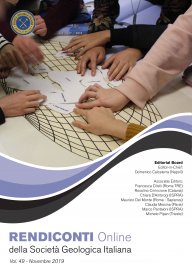
Geoscience and education: proposal of a Geo-trail at the Etna volcano
Rosalda Punturo (1), Gaetano Ortolano (1), Roberto Visalli (1), Salvatore Caffo (2), Carmelo Ferlito (1) & Rosolino Cirrincione (1)
(1) Università di Catania - Dpt. Sc. Biol. Geol. Amb. - Corso Italia 57 - 95129 - Catania (Italy). (2) Ente Parco dell'Etna, Nicolosi, Catania (Italy).
Corresponding author e-mail: rvisalli@unict.it
Volume: 49/2019
Pages: 55-61
Abstract
The present contribution aims to highlight the geological aspects of a path in the southern flank of Mount Etna, in terms of effectiveness for teaching geosciences. Recently, on the Etnean territory, several trails have been marked by local and national associations; nevertheless, it is worth noting that, up to now, no didactical geological paths have been proposed. The geo-trail here proposed is named after the geologist-naturalist Carlo Gemmellaro (1787-1866) and develops for ~ 3 km in length at an altitude of about 1300 m a.s.l. Along this itinerary, it is possible to admire several lava flows relative to eruptions occurring on the second half of the XIX century up to the beginning of the present century. These eruptions shaped the landscape of this sector of Mount Etna. The geo-trail is peculiar since, in a quite short distance, it permits geotourists to observe volcanic structures such as hornitos, pyroclastic cones, lava flows and lava channels as well as several volcanic rock types and to become familiar with the volcanic landscape. For the above reasons, the geo-trail constitutes a valid tool to educate students during their educational path through laboratory activities in the field, permitting direct learning of the volcanic processes and, at the same time, multidisciplinary approach to natural events. Finally, the XIX century eruptions are well documented by detailed historical and cultural reports, which explain also the close link between natural phenomena and emotional effects on the population.
Keywords
Get Full Text